Which of the Following Would Be Used to Track Data Movement From One System to Another?
Applicant Tracking Systems
Compare All Applicant Tracking Systems
Filters
Apply Filters:
XYour Industry
-
-
-
-
-
-
-
-
-
-
-
-
-
-
-
-
-
-
-
-
-
-
-
-
-
-
-
-
-
-
-
-
-
-
-
-
-
-
-
-
-
-
-
-
-
-
-
-
-
-
-
-
-
-
-
-
-
-
-
-
-
-
-
-
-
-
-
-
-
-
-
-
-
-
-
-
-
-
-
-
-
-
-
-
-
-
-
-
-
-
-
-
-
-
-
-
-
-
-
-
-
-
-
-
-
-
-
-
-
-
-
-
-
-
-
-
-
-
-
-
-
-
-
-
-
-
-
-
-
-
-
-
-
-
-
-
-
-
-
-
-
-
-
-
-
-
-
-
+ Show all
Your Company Size
-
-
-
-
-
-
-
-
+ Show all
Sort by

Manatal
Manatal
Manatal is the next-generation recruitment software designed for recruiting agencies and in-house HR departments across industries. Cloud-based and built with the latest technologies, it is designed to streamline recruitment proce...Read more
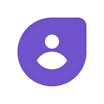
Freshteam
Freshteam
Freshteam is a cloud-based HR and applicant tracking solution offered by Freshworks. The solution helps recruiters source, screen, interview, and hire candidates. It also offers time-off management features for existing employees....Read more

Conrep
Conrep
Conrep Applicant Tracking System is a cloud-based solution that provides tools to manage time-to-hire, automates staffing process and supports recruiting teams. It is suitable for all industries and businesses of all sizes. Key fe...Read more

iSmartRecruit
iSmartRecruit
Our Applicant Tracking System and Recruiting CRM simplify every step of the hiring process in the company. Also, it streamlines everything from sourcing passive candidates to onboarding workflows with an affordable pricing model. ...Read more

BizMerlinHR
BizMerlinHR
BizMerlinHR is a cloud-based human resource management solution that helps mid to large enterprises manage the entire employee lifecycle, from onboarding to comprehensive employee records to performance management to team retentio...Read more

ZipRecruiter
ZipRecruiter
ZipRecruiter is a Web-based platform that helps streamline the overall hiring process. It enables organizations to post jobs to hundreds of job boards with one click, and users can manage all applicants through a user-friendly onl...Read more

Indeed
Indeed
Indeed for employers is a cloud-based hiring solution, which helps small to large enterprises post job vacancies and acquire qualified candidates. Features include messaging, interview scheduling, user management, role-based permi...Read more
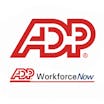
ADP Workforce Now
ADP Workforce Now
ADP Workforce Solution is suited for businesses with more than 50 employees looking to streamline HR processes. ADP Workforce Now includes capabilities such as payroll processing and tax filing, performance management, compensatio...Read more
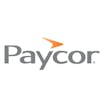
Paycor
Paycor
Paycor creates HR software for leaders who want to make a difference. Paycor's Human Capital Management (HCM) platform modernizes every aspect of people management, from the way you recruit, onboard and develop people, to the way ...Read more
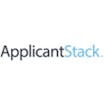
ApplicantStack
ApplicantStack
An applicant tracking system is the foundation of strategic talent management. ApplicantStack capably empowers all stakeholders: internal recruiters, hiring managers, administrators and—most importantly—applicants. ApplicantStack ...Read more
Software pricing tips
Read our Applicant Tracking Software Buyers GuideSubscription models
- Per employee/per month: This model allows you to pay a monthly fee for each of your employees.
- Per user/per month: Users pay a monthly fee for users—normally administrative users—rather than all employees.
Perpetual license
- This involves paying an upfront sum for the license to own the software and use it indefinitely.
- This is the more traditional model and is most common with on-premise applications and with larger businesses.
Rated best value for money
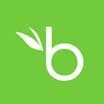
BambooHR
BambooHR
BambooHR offers small and growing companies a human resource information system (HRIS) that includes an applicant tracking system (ATS), time tracking, payroll processing, benefits administration, employee engagement and employee ...Read more

Breezy
Breezy
Breezy is a recruiting platform for small and midsize businesses. The solution provides functionality for applicant sourcing and tracking, resume parsing, and video interviews and more. The application is cloud-based and feat...Read more
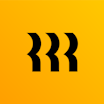
Rippling
Rippling
Rippling makes it easy to manage your company's payroll, benefits, HR, and IT—all in one, modern platform. It brings all of your employee systems and data together and helps automate your busy work, such as onboarding. With Rippli...Read more
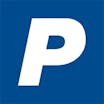
Paychex Flex
Paychex Flex
Paychex Flex is a human capital management solution that's designed using web-based modular technology and a dedicated service center to help meet the HR needs of employers of any size and industry. With a single login, users can ...Read more

Bullhorn ATS & CRM
Bullhorn ATS & CRM
Bullhorn provides cloud-based CRM solutions for relationship-driven businesses. The solution offers automated data capture and customer insight technology to help companies win customers and keep them engaged. Bullhorn's CRM ...Read more

JobDiva
JobDiva
JobDiva is a cloud-based Platform as a Service (PaaS) for staffing enterprises, incorporating a patent-protected search-and-match recruiting engine, supported by a full suite of CRM, data analytics, back-office, candidate communic...Read more

Zoho Recruit
Zoho Recruit
Zoho Recruit is a Web-based applicant tracking system that is a good fit for small to midsized businesses. The system includes automated job board posting, resume parsing and interview scheduling....Read more

Homebase
Homebase
Homebase is a cloud-based time tracking and scheduling solution that helps human resources personnel organize and manage employee schedules, timesheets and payroll. It caters to businesses in industries such as food service, retai...Read more

Workday HCM
Workday HCM
Workday HCM assists global businesses of all sizes in a variety of industry verticals with workforce planning, analysis, and execution. Workday delivers user and administrative tools across financials, HR, planning, talent, payrol...Read more

iCIMS Talent Cloud
iCIMS Talent Cloud
Support the entire candidate experience from start to finish with a unified recruitment platform. iCIMS offers best-in-class recruiting products for your hiring life cycle, available as part of one unified talent cloud platform, o...Read more
Popular Applicant Tracking Software Comparisons
Buyers Guide
Last Updated: December 10, 2021In this buyers guide, we'll cover:
- What is an applicant tracking system?
- Benefits of ATS software
- Competitive advantages of using ATS software
- Businesses sizes using ATS software
- Features Guide
- Pricing Guide
- FAQs
- Tips and tools
What is an applicant tracking system?
An applicant tracking system (ATS) is a type of software tool that organizes, tracks, and sorts job applicants. Its features include hiring workflows, job postings, candidate profiles, and applicant scoring.
Benefits of ATS software
The software tool provides businesses with a number of benefits, including:
- Customized recruitment processes. No two companies evaluate and hire workers the same way. With an ATS software, you can customize the hiring workflow for every role in your organization to standardize the steps in your recruitment process, including interview scheduling, resume parsing, and application processing. Task lists, shared calendars, and automated alerts ensure that nothing falls through the cracks.
- Automated job posting: Many ATS platforms allow users to post job openings to their company careers page, social media accounts and popular job boards, such as Indeed and LinkedIn, to be seen by interested candidates. The ability to reuse job posting templates and schedule posts in advance can save users valuable time.
- Data management: As applicants from various sources submit their resumes to be considered for positions, the tool can automatically import them into a secure database for safekeeping. Comprehensive candidate profiles can be created, searched through and filtered by a number of criteria (e.g., location, role, skills) to easily hone in on what you're looking for.
- Applicant scoring and ranking: The tool provides a centralized hub where recruiters, hiring managers and more can collaborate to evaluate applicants. Standardized rubrics ensure that everyone uses the same criteria for every candidate. Some systems can even rank candidates automatically based on what you value most in an employee at your organization for a given role based on the information provided in the job application.
- Recruiting analytics and reporting. Where are candidates falling out in the recruitment process? Which online source sends your company the best candidates? Embedded analytics in an ATS can answer these questions and highlight areas where your organization can improve. You can also generate standardized reports for compliance purposes or to keep stakeholders up to date.
Competitive advantages of using ATS software
Every business needs an edge over competitors when it comes to finding, attracting, evaluating and hiring top talent. An applicant tracking system can give you that edge by helping you:
- Hire people faster: A 2016 study by employment insight firm DHI Group found the average job vacancy in the U.S. is 29.2 days. The longer it takes for you to find and hire a qualified candidate, the longer it will take for them to become a productive employee. An ATS solution can help you diagnose bottlenecks in your hiring workflow to cut down the time it takes to fill your vacancies.
- Lower the cost per hire: It's not always easy to understand where your recruiting spend isn't providing the best return without the proper tool to crunch the numbers. Using the historical information and data visualization tools housed in an ATS platform, you can better streamline hiring processes and identify new areas for optimization to lower recruiting costs.
- Identify talent: Sometimes the unlikeliest of traits can predict worker success. With an ATS, you and your team can more consistently evaluate and rank applicants to find the best candidates. After someone's hired, you can look at their performance metrics to better understand what job applicant qualities are the most likely to translate well to specific roles within your organization.
- Scale your business: If you have a small business or are in the middle of a hiring drought, manual applicant tracking methods, such as pen and paper or spreadsheets, can get you by. However, if you're looking to grow and optimize your business, it's best recommended to invest in an ATS tool.
Businesses sizes using ATS software
Buyers of applicant tracking software come from a wide variety of industries and sizes and are generally categorized by how many employees they have in their organization:
- Small business buyers: These buyers have anywhere from 1-50 employees and don't have a department dedicated to human resources (HR) and recruiting initiatives.
- Midsize business buyers: These buyers have anywhere from 51-500 employees and are experiencing rapid growth, prompting them to hire an internal recruiter.
- Enterprise business buyers: These buyers have more than 500 employees, a hiring team and a dedicated IT department.
When you choose to purchase ATS software will depend entirely on your hiring needs, but Software Advice sees peak adoption at 1,001 to 5,000 employees:

Source: Software Needs Cycle for HR
Software related to applicant tracking systems
Here are some other types of software tools related to ATS platforms that can improve your recruiting efforts or your workforce as a whole:
- Recruiting software: Extends beyond applicant tracking needs to help recruiters manage job descriptions and searches, improve the candidate experience, perform background checks, social recruiting, and more.
- Staffing agency solutions: Specializes in helping external recruiting and staffing agencies better manage clients, external career sites, and quickly fill roles with high-quality talent. Offers features such as time and expense tracking, back office management, and email/calendar integration.
- Onboarding tools: Helps businesses automate processes to turn new hires into full-fledged employees. Features include new hire task assignment, digital signature capabilities, and onboarding form management.
- Talent management solutions: Allows HR professionals to manage the entire employee lifecycle, from attraction and hiring to management and development, with applications for applicant tracking, performance management and more.
- HR apps: Gives hiring teams, HR managers, recruiters and employees the flexibility to complete important personnel tasks on their smartphone or tablet with features, such as mobile clock-in and out and one-click payroll runs.
Features Guide
A List of Common ATS Features
ATS software offeers a wide variety of features. Here are some of the most common ones to look out for:
| Applicant tracking | Track the progress of all applicants for open roles, from start to finish. |
| Candidate profiles | Upload resumes and manage applicant details and interactions in a searchable database. |
| Job posting | Post job openings to company careers pages, social media platforms, and job boards. |
| Applicant scoring and ranking | Grade applicants based on preset criteria and rank the remaining job seekers in the running for a position. |
Feature Details and Examples
Applicant tracking: Allows you to track where all of your applicants are in the hiring process (e.g., interview, background screening) for a given role. As applicants are evaluated and pushed through to the next stage in your workflow or dropped from the running, their recruitment status gets automatically updated in your database.
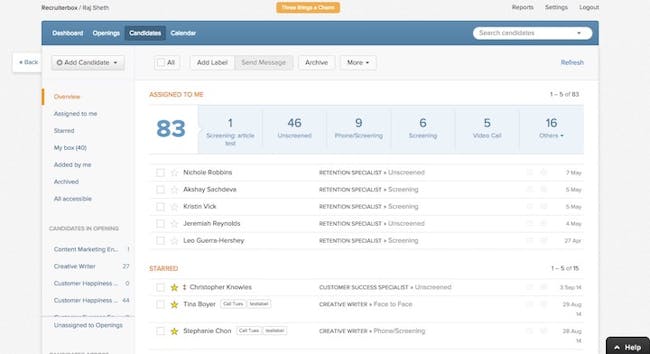
Overview of applicants in Recruiterbox (Source)
Candidate profiles: This feature allows you to maintain comprehensive profiles of all candidates, including resumes, contact information, social media profiles, assessment scores, manager feedback, interview notes, and more. You can search and filter for candidate profiles based on location, role, experience, keyword, etc.

Candidate profile in Lever (Source)
Job posting: This feature allows you to create online job listings for your vacancies and post them to your company's careers page, social media profiles and job boards. You can also schedule posts in advance, optimize postings to appear on Google and purchase job board ads from service providers that partner with ATS vendors.

Job board posting in Newton (Source)
Applicant scoring and ranking: This feature allows you and your team to score applicants based on a variety of customizable criteria related to skills, experience and personality. Once all scores are in, hiring managers can rank the candidates manually, or in some cases, the tool does it automatically.

Candidate scorecard summary in Greenhouse (Source)
ATS buyers' top-requested features
Unsurprisingly, the most common features also tend to be the most requested by buyers. According to internal Software Advice data, job posting, resume management and parsing, applicant scoring and ranking and a searchable applicant database are the top requested ATS software features among small and midsize businesses (SMBs), i.e., businesses with $50 million or less in annual revenue.
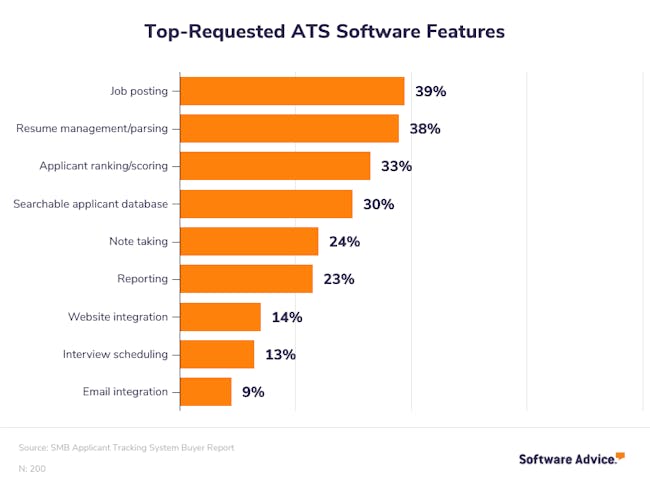
Source: SMB Applicant Tracking System Buyer Report
The features you really need
When evaluating an ATS, it's important to prioritize certain features over others depending on your needs. With that in mind, here are the most crucial features for different business sizes (see the "Business sizes using ATS software" section of this guide for business size definitions):
| Small business buyer | Applicant database: Track all of your applicants in a secure, centralized hub to eliminate the need for complex spreadsheets or paper files. |
| Midsize business buyer | Resume parsing: Automatically look for important words and phrases in submitted resumes to create a shortlist of top prospects and eliminate unqualified applicants. |
| Enterprise business buyer | Recruiting analytics: Dive deeper into your recruiting process to discover areas for improvement and optimization. |
Pricing Guide
For an accurate snapshot of what an applicant tracking platform costs, download our Applicant Tracking Systems Pricing Guide.
FAQs
What are the key functions of an applicant tracking system?
As we covered in the features guide, ATS platforms provide a number of key functions for your business, including:
- Applicant tracking: Track the progress of all applicants for open roles, from start to finish.
- Candidate profiles: Upload resumes and manage candidate details and interactions in a searchable database.
- Job posting: Post job openings to your company's career page, social network accounts, and job boards.
- Applicant scoring and ranking: Grade applicants on a variety of criteria and rank them from best to worst for open roles.
- Recruiting analytics and reporting: Analyze your historical data to discover deficiencies in your recruiting processes, and generate standardized reports for stakeholders.
What questions should I ask vendors when evaluating applicant tracking software?
It can be easy for conversations with ATS vendors to become one-sided. After all, they're trying to sell you on their system over the competition. It's important, though, to ask questions and understand everything before signing on the dotted line.
As explained in "5 Questions To Answer Before Buying an Applicant Tracking System," some important questions to ask vendors are:
How is your system priced?
As we mentioned in the pricing section, ATS vendors use a lot of different methods to price their products. Know this information well ahead of time so you can budget accordingly.
Does this system work with our recruiting strategy?
If you rely on employee referrals for quality job candidates but your ATS focuses on sourcing from social media, that's a mismatch. Make sure that you find a tool that conforms with your recruiting strategy—not the other way around.
Do I really need this feature?
It's common for buyers to purchase a popular ATS system that's way too big for their needs and pay a lot of money for functionality they don't use. Don't get distracted by bells and whistles.
Do you offer local, high-quality support?
No product is perfect. Ask questions about support options so when you encounter a problem, you can be certain that you'll be able to reach someone who can help you immediately.
Should I purchase standalone applicant tracking software or an integrated suite?
You can purchase applicant tracking software by itself (e.g., Jobvite) or as part of an integrated HR suite with other applications such as personnel tracking, payroll, and time and attendance management (e.g., BambooHR). According to internal Software Advice data, 56% of ATS software buyers choose the former while 43% choose the latter.

Source: SMB Applicant Tracking System Buyer Report
Which way you go will depend entirely on your needs. If your focus is on advanced recruiting functionality, choose a stand-alone product. If you have additional needs besides applicant tracking or value tight integration between your various HR processes, choose a suite.
Do ATS Software Vendors Update Their Products Often?
The applicant tracking software market is highly competitive, and the labor market and what employers value in their workforce are constantly in flux. Because of this, ATS software vendors are constantly adding features to their flagship products to gain an edge and attract attention.
Stay on top of the latest functions to look out for with our article, "5 Recruiting Trends in 2017 (and the 9 ATS Features You Need to Capitalize on Them)."
What Are Some Drawbacks I Should Watch Out For?
Don't expect ATS platforms to be the cure-all for your hiring woes. While these systems can help you organize, streamline, and scale your recruiting operations, they can't fix bad hiring strategies or an inferior employer brand.
Also, keep in mind that a poorly chosen or implemented applicant tracking system can do significant damage to your online candidate experience, which can cause talented applicants to drop out of your hiring funnel. Take time to ensure this transition for job seekers into your system to apply for positions is seamless, regardless of device or web browser.
Tips and tools
Build a Business Case for your investment
It can be tough to convince executives to invest in a new tool. When making your business case, focus on these three ROI drivers:
- Lower your cost per hire: Using embedded analytics, you can identify areas to refocus your recruiting budget and save your company money.
- Hire people faster: Being able to discover bottlenecks in your hiring process can allow you and your team to evaluate and hire talent quicker and fill empty seats faster.
- Retain better talent: ATS software can help your team uncover which traits truly translate to role success, increasing worker productivity.
Relevant Articles
Here are some recent articles about ATS platforms you should check out:
- "SMB Applicant Tracking System Buyer Report"
- "5 Recruiting Metrics That Matter When Measuring Success"
- "Can Software Solve Your Diversity Issues?"
- "The Best Job Boards for Your Recruiting Dollar"
Popular ATS Software Comparisons
Check out some recent articles comparing ATS software products:
- Top iCIMS Alternatives
- ADP vs. Paychex
- Paylocity vs. ADP
- Gusto vs. Paycor
Recent Events in the ATS Software Market
Here are some important recent events concerning ATS vendors and the ATS software market:
- Google debuts Google Hire: In April 2017, a website went live for what's predicted to be Google's entry in the ATS software market: Google Hire. Details about the product are scarce, but Google is expected to reveal more information soon.
- Microsoft debuts Dynamics 365 for Talent: In April 2017, Microsoft announced a new recruiter-focused offering in its popular Dynamics suite called Dynamics 365 for Talent. The platform integrates with LinkedIn, which Microsoft acquired in 2016.
- Saba Software acquires Halogen Software: In February 2017, Saba Software announced that it had acquired ATS vendor Halogen Software, makers of Halogen Talent Acquisition.
Which of the Following Would Be Used to Track Data Movement From One System to Another?
Source: https://www.softwareadvice.com/hr/applicant-tracking-software-comparison/
0 Response to "Which of the Following Would Be Used to Track Data Movement From One System to Another?"
Post a Comment